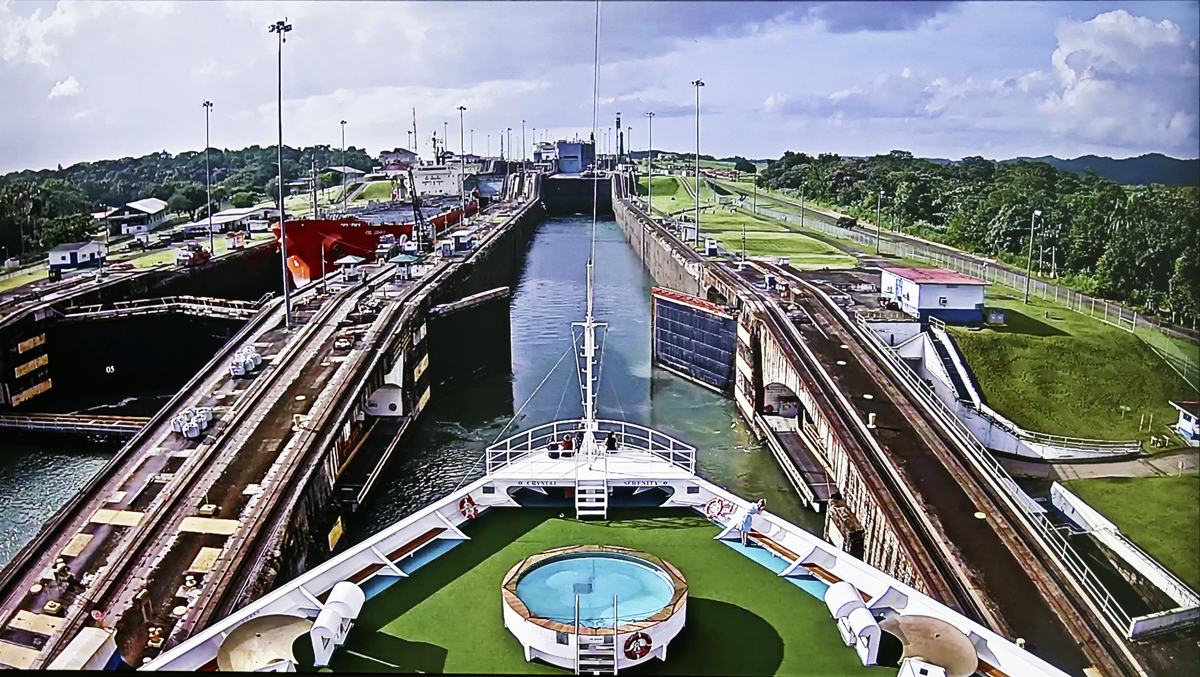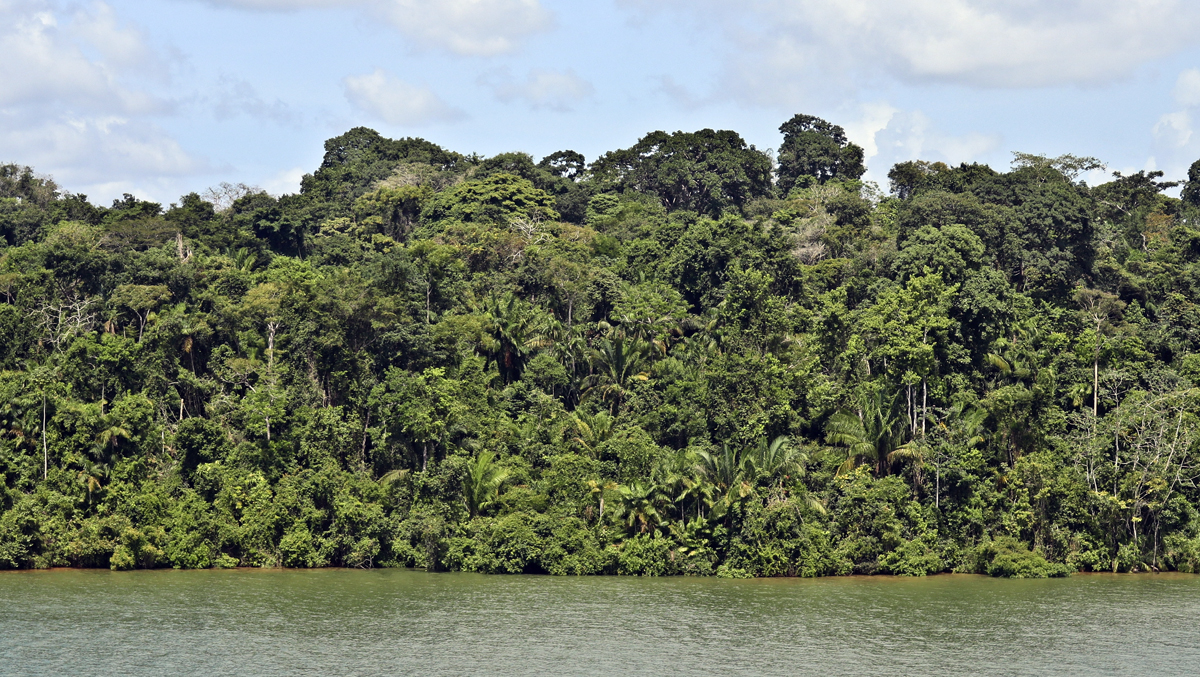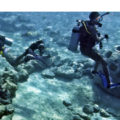
Clang, clang, clang go the cute little electric trolleys that are still known as mules. Crystal Serenity seems to move in slow motion as the lock gates open and close at a stately pace. It takes from dawn to dusk to travel just 60 miles; but what a day it is.
The Panama Canal is more than a century old. It’s well-worn and in many ways antique, but it still ranks as one of the peak cruise experiences. The waterway across the narrow strip of land dividing the Atlantic and Pacific has an incredibly nostalgic story behind it.
It’s a fantastic adventure to be aboard Crystal Cruises’ newly renovated Crystal Serenity as the swirl of activity goes on all around on a Panama Canal crossing. Here’s why it’s still a must-do:

Getting there is only part of the fun
We’re cruising on Crystal Serenity from Florida around Latin America to California and the itinerary specifies a daytime crossing of the canal. That’s important, because doing it by day is not a guarantee on all cruise itineraries. The last time I took a Panama Canal cruise–on a line that will remain nameless here–the timing was all wrong. That ship actually didn’t enter the first lock until 9 at night, and it passed all the highlights of the crossing in total darkness.
Crystal Serenity sailed here from Cartagena, Colombia and we’re heading for Costa Rica, but today’s only activity is to watch the ever-changing show around us in Panama.

The clock starts ticking
The surrounding forest is glistening from an overnight shower—they don’t call this the rain forest for nothing—but the sky is stunningly blue and the sun is rising brilliantly as Serenity lines up with the first of the Gatun locks at 7:30 a.m.
The daily program has a minute by minute description of where we’ll be throughout the day. The canal journey is timed precisely to move as many ships as possible through each day. If Crystal Serenity hadn’t queued up in time, we could have ended up getting bumped to the back of the line and idling for hours.
Guests who want to see every bit of the action are advised to move from the front to the rear of the ship as we pass through locks. But there’s plenty to see by just settling in on your private verandah or in a cozy chair in Serenity’s beautifully re-decorated Palm Court observation lounge, which has a panoramic viewing platform over the bow of the ship.
An obvious advantage of being on a Crystal cruise is all drinks are complimentary, so why not celebrate with a cocktail–or two– in the canal?

Why a mule?
The locks in the canal system that first opened in 1914 still have the solid feel of the machine age about them, all wood and iron with armies of workers wearing hard hats bustling around. The system was designed when sailing ships were still standard and mules guided barges through canals.
Today’s mules look like they came from a homebuilt model train set, clad in shiny sheet metal with flashing lights and copper bells that look like they belong on a boxing ring. Just as they did in the days of sail, the mules keep the ship on the straight and narrow in the tight locks. Even though they only weigh 5 tons, they move on geared tracks so they can pull up to 35 tons.
Crystal Serenity at 106 feet wide comes extremely close to maxing out on each side of the 110 foot wide locks. But once snug inside, the gates close and we start to rise as water is let in.
You can see how much we’re actually going to rise by looking at a ship down-bound that seems to hover in the sky in the distance.

Sailing east to go west
By a quirk of geography we’re actually heading east, with the sun rising over the Gatun Locks. Panama at this point forms a backwards S shape and the entrance is northwest of the canal.
The route takes us through three locks into Gatun Lake, which for most of the route seems more like a river, its banks lush with jungle-like tropical trees and no signs of human habitation. Occasionally, there’s a construction zone which is a base for dredges that have to keep continually busy to keep silt from clogging the route. Construction has never really stopped on this canal.

The back story’s a classic
A wonderful lecture slide show on Serenity before we arrived in Panama has regaled us with stories of why the canal was such a feat and is still remarkable today. There’s a complex history of mistakes, malaria, mudslides and mis-adventures by the French before the Americans bought the half-built project at a fire-sale price and made it happen.
A man, a plan, a canal…Panama. Bully for Teddy Roosevelt and Yankee ingenuity and all that–makes for a fascinating tale, but it’s more than we need to go into here.
The key details you need to know is that the canal is at the narrowest neck of land between the big oceans and it couldn’t be at sea level because it has to cross the rocky Continental Divide. Entire mountains had to be levelled and hillsides cut back in a series of steps to prevent landslides. Mudslides were daily occurrences. Explosions of dynamite by accident were common because of the steamy humidity.
Workers had to be enticed to take on the risky work in brutal heat and malaria swamps. There were tales of gold and it brought shiploads of fools looking for a lucky strike that never happened who ended up working on the canal. Lots of workers also came from Barbados attracted by pay that was somewhat higher than toiling in the cane fields.

And what of the new Panama Canal?
As we sail we can see the parallel new canal system that opened in 2016. Even with modern equipment it took years to build its series of bigger locks for today’s monster ships. But the new canal has had a lot of teething problems and it’s frankly not as scenic, so the old canal is still the go-to favorite for cruise ships.
Most of the traffic on both canals today consists of tankers, container ships and big blimp-like ships whose holds are parking garages for new Asian cars headed to market in North America or Europe.

The bottom line is: it’s fun
Ten hours after we entered the canal in Gatun Locks, we emerged from Miraflores. It took us from dawn to dusk to go just 60 miles . The toll for a ship the size of Crystal Serenity is $200,000 a crossing. But it’s actually worth it, because it saves more than a week of treacherous sailing around South America to get from ocean to ocean.
If someday in the future we can beam up and get from sea to sea instantly, I’ll bet cruisers will still prefer to cross the old-fashioned way, guided by little clang, clanging mules.






Thanks for your insightful article. I love cruising, but living in Vancouver, a Panama voyage somehow never interested me. Then one day I got a really good deal Miami to L.A. Since then, it has become a definite favourite. The weather was great (not always the case we heard). The coolest thing is being on your ship and seeing other huge ships up close as they squeeze right by. Can’t wait to do it again!